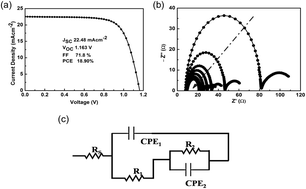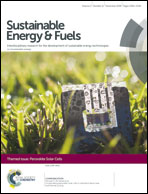Blue and red wavelength resolved impedance response of efficient perovskite solar cells†
Abstract
The identification of recombination centers in perovskite solar cells is highly challenging. Here, we demonstrate the red and blue excitation wavelength resolved impedance response in state-of-the-art perovskite solar cells (PSCs) providing insights into charge recombination and ion accumulation. To get insight into the interfacial electronic characteristics, we fabricated PSCs with a planar architecture containing state-of-the-art triple-cation perovskite materials as absorber layers. The capacitance–frequency response under various blue and red illumination conditions were used to investigate interfacial charge accumulations and found that under high energy photons irradiation maximum charge or ion accumulations at interface (ETL/perovskite) take place. Ideality factor of PSCs was also calculated from the obtained value of high frequency resistance equaling 2.1 and 1.8 for devices measured under blue and red excitation wavelength, respectively. Our study illustrates that EIS measurements at different excitation wavelengths, reveals information about charge or ion accumulation and also provides a tool to diagnose PSCs in a more localized way.

- This article is part of the themed collection: Perovskite solar cells


 Please wait while we load your content...
Please wait while we load your content...